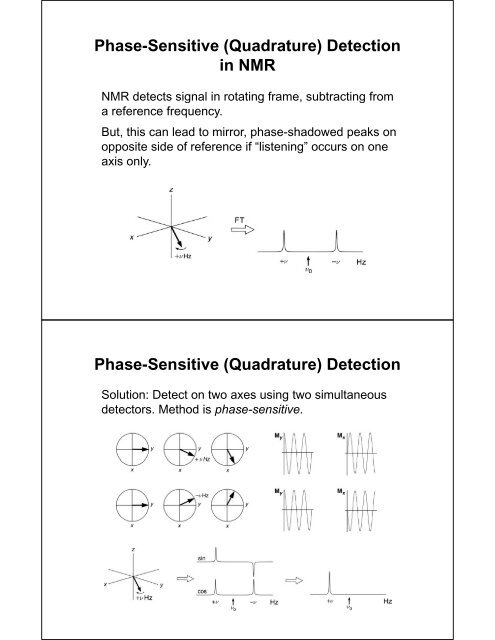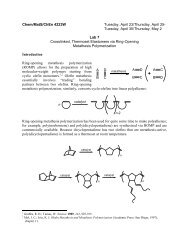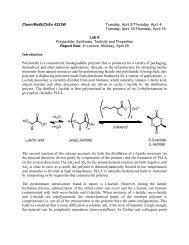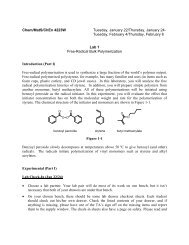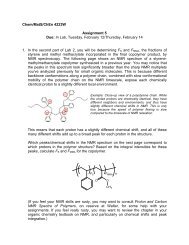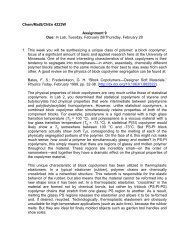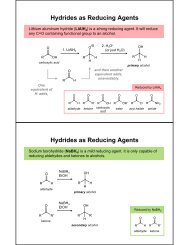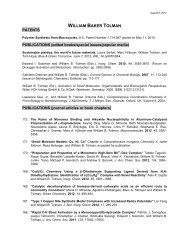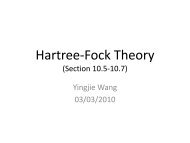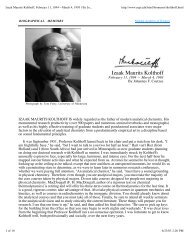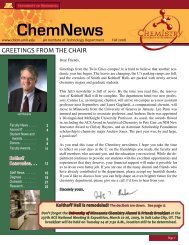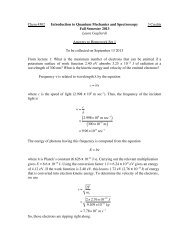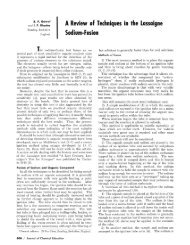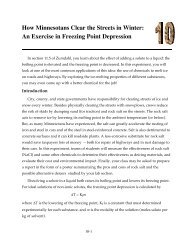Phase-Sensitive (Quadrature) Detection i NMR n NMR Phase ...
Phase-Sensitive (Quadrature) Detection i NMR n NMR Phase ...
Phase-Sensitive (Quadrature) Detection i NMR n NMR Phase ...
Create successful ePaper yourself
Turn your PDF publications into a flip-book with our unique Google optimized e-Paper software.
<strong>Phase</strong>-<strong>Sensitive</strong> (<strong>Quadrature</strong>) <strong>Detection</strong><br />
in <strong>NMR</strong><br />
<strong>NMR</strong> detects signal in rotating frame, subtracting from<br />
a reference frequency.<br />
But, this can lead to mirror, phase-shadowed peaks on<br />
opposite side of reference if “listening” occurs on one<br />
axis only.<br />
<strong>Phase</strong>-<strong>Sensitive</strong> (<strong>Quadrature</strong>) <strong>Detection</strong><br />
Solution: Detect on two axes using two simultaneous<br />
detectors. Method is phase-sensitive.
<strong>Phase</strong>-<strong>Sensitive</strong> (<strong>Quadrature</strong>) <strong>Detection</strong><br />
Procedure is optimized by phase-cycling.<br />
Scans collected in sets of four pulses.<br />
and then two more, -x(-cos, -sin) and -y(-sin, cos).<br />
Gradient-Enhanced COSY (gCOSY)<br />
<strong>Quadrature</strong><br />
detection<br />
lengthens time<br />
(x4) of 2D <strong>NMR</strong>.<br />
Can solve this by<br />
using pulsed-field<br />
gradient—vertical<br />
range of B 0 field,<br />
applied via RF<br />
coil.<br />
<strong>NMR</strong> tube
Double-Quantum Filtered COSY<br />
(DQF-COSY)<br />
Occasional problem: Diagonal peaks overwhelm<br />
crosspeaks close to diagonal.<br />
Solution:<br />
Apply “quantum filter” to discriminate<br />
intramolecular coupling from intermolecular<br />
coherence transfer.<br />
Issues: Loss of<br />
sensitivity,<br />
splitting patterns<br />
observed in 2D.<br />
1<br />
H<br />
Double-Quantum Filtered COSY<br />
(DQF-COSY)<br />
COSY-90<br />
DQF-COSY
Heteronuclear Correlation Spectroscopy<br />
(HETCOR)<br />
Objective:<br />
Correlate protons with attached carbons.<br />
Problem:<br />
13<br />
C <strong>NMR</strong> is inefficient, so HETCOR very<br />
insensitive.<br />
f 13 2 must be C<br />
spectrum,<br />
because 1 H →<br />
13<br />
C coherence<br />
t 1 ( 1 H)<br />
unlikely. f 2 ( 13 C)<br />
Often requires high-concentration or pure (liquid) sample.<br />
Heteronuclear Multiple-Quantum<br />
Correlation (HMQC) Spectroscopy<br />
Alternative method to 1 H- 13 CHETCOR<br />
HETCOR.<br />
Uses inverse detection: 13 C frequencies are detected as<br />
echoes in 1 H channel.<br />
(This avoids low sensitivity of<br />
13<br />
C<strong>NMR</strong>.)<br />
1<br />
H<br />
13<br />
C
HMQC<br />
5<br />
2<br />
1<br />
Each peak<br />
corresponds to a<br />
1<br />
J(CH) correlation<br />
(i.e., a C-H bond).<br />
Particularly useful<br />
in identifying<br />
inequivalent<br />
geminal H’s.


